interviewed by Carl Slaughter
Jacey Bedford uses the Milford Method for workshopping/critiquing. She uses Diabolical Plots’ Submissions Grinder for submitting. Her debut novel is 171,000 words, so she apparently doesn’t suffer from writer’s block. She has been participating in workshopping/critiquing 20 years. She is one of the organizers of the Northwrite SF Writers’ Group and the Milford SF Writers Conference. She is represented by Maass agent Amy Boggs, who was also interviewed by Diabolical Plots. She has signed a 3 book contract with DAW and Empire of Dust is out this month.
You’ve done a lot of workshopping and critiquing. First, what’s the difference between workshopping and critiquing? Is a writers conference synonymous with a writers workshop? What are the advantages and disadvantages of workshopping? What should you expect and not expect from worshopping. What are the advantages and disadvantages of critiquing? What should you expect and not expect from critiquing?
I’ve been part of various critique groups over the last twenty years, both face to face and by email, and I’m also one of the organisers of the Northwrite SF Writers’ Group and the Milford SF Writers Conference which is a week long event where writers take chunks of their works in progress or complete short stories for both critiquing and workshopping. In Milford terms workshopping just means a general discussion where fellow writers will make suggestions and dissect ideas, sometimes in macro terms, sometimes micro. This usually goes above and beyond what you would probably get in a normal critique session and usually evolves throughout the week. When you have fifteen writers kettled together deep discussions are often the result. (Though, of course there are workshops which are more like courses where there is a leader or moderator and writing exercises may be involved. I haven’t taken part in any of those, so I’m not qualified to talk about them.)
At Milford each writer submits (in advance) up to 15,000 words in one or two pieces. The week is organised to include reading/writing time (mornings), formal critique time (afternoons) and social time (evenings). There are no teachers and no students. At Milford every writer is equal, whether they have a string of published novels or a single short story sale. The critique sessions use what has become known as the Milford Method which is now used in many other writers’ groups. (Just Google Milford Method and see how many hits you get.) Basically each participant, in rotation, spends up to four minutes (timed) giving their critique of the work at hand. No interruption, whether by the author or anyone else, is allowed during this stage of the proceedings. After everyone has spoken the author gets an uninterrupted right of reply and then this is followed by a more general discussion which is often continued over a good glass of red in the library after dinner.
Is Milford a workshop? A conference? A critique session? The short answer is: all of the above and more. It’s called a conference because historically that’s what James Blish called it when he brought it over from the USA to the UK in 1972 – way before my time. Should it really be called a conference? Is it a conference? I haven’t a clue, but it’s the name we inherited.
Before Milford I was part of a small email critique group which we called RECOG. There were ten of us and we took turns to submit a piece of up to 10,000 words in rotation. So there would be a piece to critique every ten to fourteen days and your own turn would come round every eight to ten weeks. The critiques from participants tended to vary from macro critiques to detailed line edits. Very occasionally if someone was having a plot problem there would be a request for ‘plot-noodling’ in which ideas would be exchanged. We were truly international with writers from the UK, USA, New Zealand and Finland, so there was no face-to-face interaction at all.
Writing is a solitary experience, so writers’ groups are great because apart from the obvious advantages of getting a second (third, fourth, fifth etc.) opinion on your work, the transmission of information, expertise and enthusiasm is vital. It’s easy to get too close to your own work so you lose track of the big picture. Someone else can often pick out what’s wrong, or tell you what’s right. Of course if you have nine other writers’ opinions you may get some conflicting ideas. At the end of the day it’s still your book and where it goes is your responsibility.
Setting up your own writing group is an option if there isn’t a suitable one nearby, but you might want to try critiquing by joining an online group like Critters first to see if it’s for you. Beware some local writing groups that exist just to read their work aloud and pat each other on the back. Some people get into creative writing as a form of therapy or for social reasons (which is all very valid if that’s what you want) but if you are working towards publication, you need a serious group of like-minded writers who are going to inspire each other to greater efforts. It helps if it’s genre specific if that’s where your writing ambitions are.
What about your own experience. What was your writing life like before and after workshopping and critiquing?
I’ve always written. My first novel attempt was at the age of fifteen. I managed six chapters, typed out very slowly on an ancient Imperial 66. Until the advent of the internet I was a secret writer, amassing many unread manuscripts, mostly in longhand. As soon as I got online, back in the 1990s, I was lucky to find two usenet newsgroups, misc.writing and rec.arts.sf.composition. They were not critique groups, but offered discussions about the writing process and delivered important information about the nuts and bolts of welding words together.
Critique groups are not just important for the critique you get, of course, but also for the critiques you give. You get to read a lot of work by other writers, some much more experienced than you, and some much less. You see mistakes and critique them (thoroughly and constructively, but also sensitively) and learn not to make the same mistakes yourself. Whether online or face to face, you need to be able to commit to a critique group. It can be hard work, but very rewarding.
Your debut novel has just come out. DAW is a very distinguished publisher. How did you break into that market? Did you go through an agent, did you meet the editor at a convention, did you do some networking, or did you just submit through the slushpile?
I’d had an agent, whom I liked a lot, but who made the decision to cease her agency business, so while I was looking for another agent I sent a manuscript to DAW, but with an introduction from another DAW author (met at Milford). It was kind of a slushpile thing, but because I had an introduction I was able to land it directly on Sheila Gilbert’s desk. Sheila Gilbert and Betsy Wollheim are the two managing editors and the leading lights of DAW. Though DAW is now part of the Penguin Group it still feels like a family firm, and, of course, Betsy is the daughter of Donald A Wollheim, the founder. It’s a fabulous publisher to work with. I’ve had the pleasure of meeting Sheila and Betsy at both the World Fantasy Convention in Brighton in 2013 and Worldcon in London in 2014, which was marvellous because normally we’re on opposite sides of the Atlantic.
What kind of feedback did you get from Sheila Gilbert? What was it about “Empire of Dust” or your writing that appealed to her? What’s it like working with her? You signed a 3 book contract. Will they be a trilogy? What’s the timeframe for the release of the next 2 books?
When Sheila emailed to say she’d like to buy my manuscript I was gobsmacked (surprised/delighted/elated). She asked when she could call me and I said NOW! The phone rang almost before I’d hit send on the email. The manuscript Sheila bought was my magic pirate adventure, which – as I’m sure you’ve guessed – is not the first book that’s been published.
Sheila bought Winterwood and then asked that wonderful question: What else have you got? She liked the idea of science fiction as well as fantasy so I sent her Empire of Dust – at that point a finished novel but only 123,000 words long (actually cut back to that on the advice of a previous agent). In the meantime I’d accepted an offer of agency representation from Amy Boggs at Donald Maas, so the actual negotiations went to Amy at this point. The next thing I knew Amy called me with DAW’s offer of a three book deal for Empire of Dust, a sequel (as yet unwritten) and Winterwood. It turned out that DAW’s publication schedule meant that there was a gap for the space opera in November 2014, so Sheila decided that would be the first one out. The sequel, Crossways, which is at the editing stage, is scheduled for August 2015 and Winterwood (which may yet have a title change) will be published in 2016.
I hope to be able to write more in my psi-tech universe. It has the potential to be a series rather than a trilogy. Of course, I have other novel projects on the go, too.
Sheila is a hands-on editor, but rather than getting a manuscript back from her covered in blue pencil, I get extensive and detailed phone calls or a face to face meeting over breakfast at a convention. When Sheila talks I listen (and scribble notes like mad) because she’s vastly experienced. She quickly spots where my character and worldbuilding holes are and gives me the opportunity to fill them without being prescriptive. If anything DAW tends to like long books, so Sheila is keen to encourage relevant detail. I ended up adding in a lot of what I’d cut out to please my previous agent and Empire of Dust grew from 123,000 words to 171,000 words between submission and publication.
What themes do you address in Empire of Dust?
The broad theme is trust and betrayal, but there are lots of strands which include corporate over-growth, colonialism, personal freedom, and of course it’s all told via a very personal story because themes affect characters. Megacorporations, more powerful than any individual planetary government, even that of Earth, are racing each other to establish colonies and gobble up resources, using as their agents psi-techs, humans implanted with telepath technology, who are bound to the megacorps – if they want to retain their sanity. Empire of Dust is the story of what happens when two psi-techs from rival megacorps (Cara Carlinni and Reska (Ben) Benjamin) both fall foul of their respective bosses and hook up. What happens next turns into a galaxy-spanning manhunt and endangers a new colony. It’s fast-paced with a twisty plot. I had a whale of a time writing it.
Are you treating us to any short stories anywhere?
I don’t write many short stories because writing novels takes up pretty much all of my writing time, but I do have a few published recently. My story, “The Loneliness of the Long Distance Panda”, came out in Nature Magazine in 2011 and was also done as a podcast and republished in the Futures 2 anthology in August 2014. Then it was translated into Galician for the Spanish magazine Nova Fantasia, and has been bought for the online publication, Buzzy Mag for 2015. I’ve just sold a short ghost story, “Last Train”, to Grievous Angel, again for publication in 2015, and I have a short-short story, “Root and Branch”, out in the September 2014 issue of Albedo One, the Irish SF magazine. There’s a list of story publications on my website including some upcoming ones. I can particularly recommend the anthology River, edited by Alma Alexander, which contains my story, Floodlust.
I used to be very bad at sending out my short stories. I would send out a batch and then gradually they would come back in with rejection slips (or sometimes sell, of course) and then they’d sit on my hard drive where they weren’t any use at all until the next time I worked up enthusiasm to submit them all again. My Milford buddy, Deborah Walker, has a motto which is ‘Submit until your fingers bleed.’ She’s inspired me to make sure that as soon as a story is rejected by one magazine or anthology I send it out to another, so my stories are always out there looking for a home. Unsurprisingly I’ve actually sold a lot more stories since I started following Deb’s advice. It’s the writer equivalent of ‘If you don’t ask, the answer is always no.’ I use the Submission Grinder at Diabolical Plots to research suitable markets and track submissions and then I back it up with my own database to I know exactly where all my stories have been. I’ve just sent Crossways off to my editor, so I have a few weeks before I get the editorial comments back. Maybe it’s time to write a couple of short stories. Watch this space†�
http://www.jaceybedford.co.uk
http://jaceybedford.wordpress.com
http://www.milfordSF.co.uk
Twitter: @jaceybedford
Facebook: https://www.facebook.com/jacey.bedford.writer
Book buy links:
Amazon.co.uk
Amazon.com
Amazon.com Kindle edition http://www.amazon.com/dp/B00JJXV5PI?tag=freshfiction-20&link_code=as3&creativeASIN=B00JJXV5PI&creative=373489&camp=211189
Barnes and Noble / Nook
http://www.barnesandnoble.com/w/empire-of-dust-jacey-bedford/1119058678?ean=9780756410162
The Book Depository
http://www.bookdepository.com/Empire-Dust-Jacey-Bedford/9780756410162
 Carl Slaughter is a man of the world. For the last decade, he has traveled the globe as an ESL teacher in 17 countries on 3 continents, collecting souvenir paintings from China, Korea, Thailand, Vietnam, and Egypt, as well as dresses from Egypt, and masks from Kenya, along the way. He spends a ridiculous amount of time and an alarming amount of money in bookstores. He has a large ESL book review website, an exhaustive FAQ about teaching English in China, and a collection of 75 English language newspapers from 15 countries.
Carl Slaughter is a man of the world. For the last decade, he has traveled the globe as an ESL teacher in 17 countries on 3 continents, collecting souvenir paintings from China, Korea, Thailand, Vietnam, and Egypt, as well as dresses from Egypt, and masks from Kenya, along the way. He spends a ridiculous amount of time and an alarming amount of money in bookstores. He has a large ESL book review website, an exhaustive FAQ about teaching English in China, and a collection of 75 English language newspapers from 15 countries.



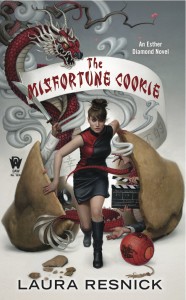
 LAURA RESNICK: An editor once cited Barbara Michaels aka Elizabeth Peters to me as an example of a writer whose career was held back for years by bad covers. Peters died last year (peacefully at home, at the age of 85) after a career which included many New York Times bestselling novels. But that success came some 20 years and many well-reviewed books into her career, and there was a noticeable shift in packaging that accompanied her well-deserved success. For years, publishers were giving her muddy, generic covers that conveyed nothing of the tone of her books, and she developed her audience strictly on her own merits via word-of-mouth, with no help at all from her dreadful packaging. Then if you look at the packaging she started getting around the mid-1990s, you can see a definite shift in quality of the covers, which accompanied her rising sales. In particular, the eventual packaging of her Amelia Peabody series (the early books, poorly packaged, were also repackaged with the new look) was a winner, and the series was commercially very successful for years (she was working on another Amelia Peabody book when she died).
LAURA RESNICK: An editor once cited Barbara Michaels aka Elizabeth Peters to me as an example of a writer whose career was held back for years by bad covers. Peters died last year (peacefully at home, at the age of 85) after a career which included many New York Times bestselling novels. But that success came some 20 years and many well-reviewed books into her career, and there was a noticeable shift in packaging that accompanied her well-deserved success. For years, publishers were giving her muddy, generic covers that conveyed nothing of the tone of her books, and she developed her audience strictly on her own merits via word-of-mouth, with no help at all from her dreadful packaging. Then if you look at the packaging she started getting around the mid-1990s, you can see a definite shift in quality of the covers, which accompanied her rising sales. In particular, the eventual packaging of her Amelia Peabody series (the early books, poorly packaged, were also repackaged with the new look) was a winner, and the series was commercially very successful for years (she was working on another Amelia Peabody book when she died).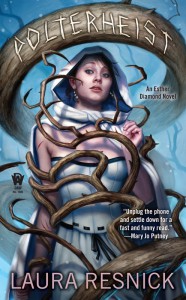 LAURA: At large publishing conglomerates (ex. Hachette, HarperCollins, Penguin Random House, MacMillan, and Simon & Schuster), too often the people making decisions about packaging are unfamiliar with the book or the author’s work,and therefore also unfamiliar with the author’s audience, who are the people the cover needs to attract. I have even been told anecdotes by wearily amused art directors about book covers being directed by senior people in the corporate hierarchy who don’t read books and who have no art or design background whatsoever, but who, for one reason or another, want cover control. To give just one example of how truly absurd the process can get, one art director at a major house told me that for a year or two, most of that company’s major releases had red covers because the Chief Financial Officer’s girlfriend liked red, and he wanted to make her happy.
LAURA: At large publishing conglomerates (ex. Hachette, HarperCollins, Penguin Random House, MacMillan, and Simon & Schuster), too often the people making decisions about packaging are unfamiliar with the book or the author’s work,and therefore also unfamiliar with the author’s audience, who are the people the cover needs to attract. I have even been told anecdotes by wearily amused art directors about book covers being directed by senior people in the corporate hierarchy who don’t read books and who have no art or design background whatsoever, but who, for one reason or another, want cover control. To give just one example of how truly absurd the process can get, one art director at a major house told me that for a year or two, most of that company’s major releases had red covers because the Chief Financial Officer’s girlfriend liked red, and he wanted to make her happy.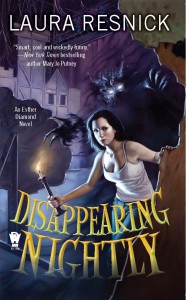 LR: Well, “marketing” is a broad term, involving a lot of areas unrelated to the book cover. It is, in essence, the question of how to get lots of people who are likely to enjoy the book to pick it up in the first place.
LR: Well, “marketing” is a broad term, involving a lot of areas unrelated to the book cover. It is, in essence, the question of how to get lots of people who are likely to enjoy the book to pick it up in the first place.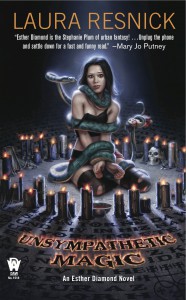 LR: Not alienating relationships at the publishing house is a matter of professionalism in all things, not just covers. And, frankly, I’ve worked with a couple of publishers in the past which are so unprofessional and so contemptuous of authors that there’s really no way to get anything done without alienating them. (Also, in retrospect, I don’t regret the instances where I alienated publishing staff in order to protect my books. I regret the few instances where I foolishly backed off on protecting my books in order to try to preserve relationships with publishers; this turned out to be the wrong decision in every instance. When a book is handled badly, sales suffer, and so the relationship is destroyed anyhow,because publishers publish for money, not love, friendship, loyalty, or honor.)
LR: Not alienating relationships at the publishing house is a matter of professionalism in all things, not just covers. And, frankly, I’ve worked with a couple of publishers in the past which are so unprofessional and so contemptuous of authors that there’s really no way to get anything done without alienating them. (Also, in retrospect, I don’t regret the instances where I alienated publishing staff in order to protect my books. I regret the few instances where I foolishly backed off on protecting my books in order to try to preserve relationships with publishers; this turned out to be the wrong decision in every instance. When a book is handled badly, sales suffer, and so the relationship is destroyed anyhow,because publishers publish for money, not love, friendship, loyalty, or honor.)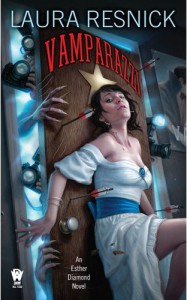 LR: Authors are doing this in the self-publishing world,and in many cases, very effectively and successfully. In the traditional publishing world, though, you don’t want to do this. One, your publisher won’t go along with it; two, why on earth would you sign a contract that funnels the majority of the income to a publisher if they aren’t going to pay for the packaging? If you want to do the packaging yourself, then self-publish. (For some examples of great self-published covers, check out some awards sites for “best of” indie and self-published cover art.)
LR: Authors are doing this in the self-publishing world,and in many cases, very effectively and successfully. In the traditional publishing world, though, you don’t want to do this. One, your publisher won’t go along with it; two, why on earth would you sign a contract that funnels the majority of the income to a publisher if they aren’t going to pay for the packaging? If you want to do the packaging yourself, then self-publish. (For some examples of great self-published covers, check out some awards sites for “best of” indie and self-published cover art.)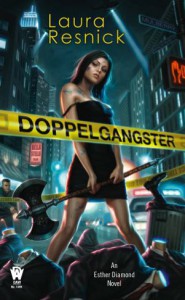 LR: The Esther Diamond covers are illustrated by the brilliant Dan Dos Santos. He’s a Chesley Award winner, a five-time Hugo Award nominee, and has won or been nominated for numerous other awards for his art. He’s also prolific, so you’ve probably seen his art on numerous other book covers.
LR: The Esther Diamond covers are illustrated by the brilliant Dan Dos Santos. He’s a Chesley Award winner, a five-time Hugo Award nominee, and has won or been nominated for numerous other awards for his art. He’s also prolific, so you’ve probably seen his art on numerous other book covers.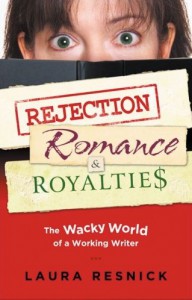 LR: The market and the book/publishing world have changed a great deal during the years I’ve been writing professionally, yet I find that the two most common mistakes that aspiring writers make have not changed at all: not writing enough and not educating themselves about the business. And so my advice hasn’t changed, either. It’s still:
LR: The market and the book/publishing world have changed a great deal during the years I’ve been writing professionally, yet I find that the two most common mistakes that aspiring writers make have not changed at all: not writing enough and not educating themselves about the business. And so my advice hasn’t changed, either. It’s still: